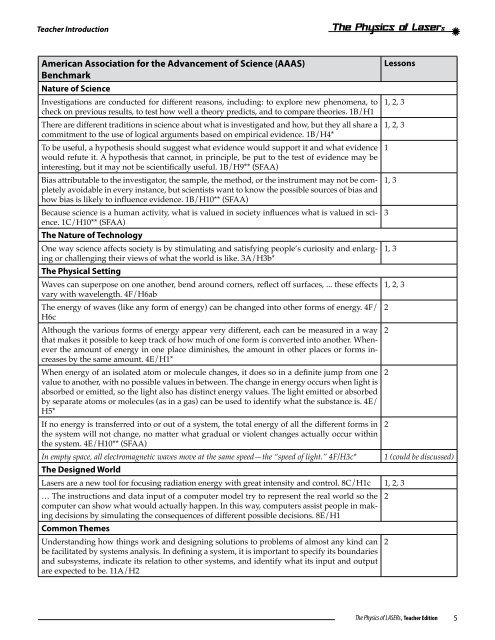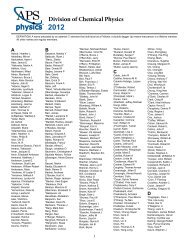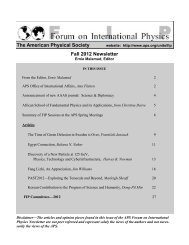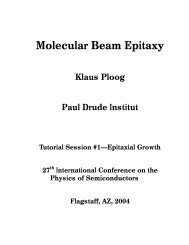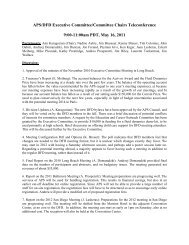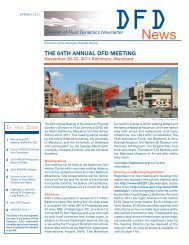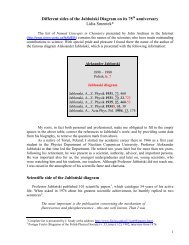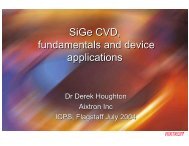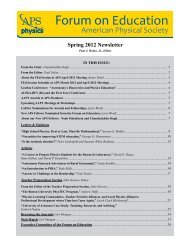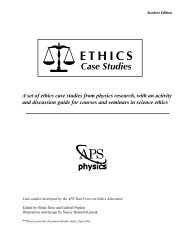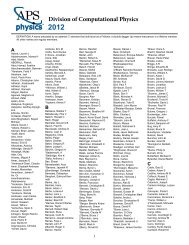The Physics of LASERs - American Physical Society
The Physics of LASERs - American Physical Society
The Physics of LASERs - American Physical Society
Create successful ePaper yourself
Turn your PDF publications into a flip-book with our unique Google optimized e-Paper software.
Teacher Introduction<br />
<strong>American</strong> Association for the Advancement <strong>of</strong> Science (AAAS)<br />
Lessons<br />
Benchmark<br />
Nature <strong>of</strong> Science<br />
Investigations are conducted for different reasons, including: to explore new phenomena, to 1, 2, 3<br />
check on previous results, to test how well a theory predicts, and to compare theories. 1B/H1<br />
<strong>The</strong>re are different traditions in science about what is investigated and how, but they all share a 1, 2, 3<br />
commitment to the use <strong>of</strong> logical arguments based on empirical evidence. 1B/H4*<br />
To be useful, a hypothesis should suggest what evidence would support it and what evidence 1<br />
would refute it. A hypothesis that cannot, in principle, be put to the test <strong>of</strong> evidence may be<br />
interesting, but it may not be scientifically useful. 1B/H9** (SFAA)<br />
Bias attributable to the investigator, the sample, the method, or the instrument may not be com- 1, 3<br />
pletely avoidable in every instance, but scientists want to know the possible sources <strong>of</strong> bias and<br />
how bias is likely to influence evidence. 1B/H10** (SFAA)<br />
Because science is a human activity, what is valued in society influences what is valued in sci- 3<br />
ence. 1C/H10** (SFAA)<br />
<strong>The</strong> Nature <strong>of</strong> Technology<br />
One way science affects society is by stimulating and satisfying people’s curiosity and enlarg- 1, 3<br />
ing or challenging their views <strong>of</strong> what the world is like. 3A/H3b*<br />
<strong>The</strong> <strong>Physical</strong> Setting<br />
Waves can superpose on one another, bend around corners, reflect <strong>of</strong>f surfaces, ... these effects 1, 2, 3<br />
vary with wavelength. 4F/H6ab<br />
<strong>The</strong> energy <strong>of</strong> waves (like any form <strong>of</strong> energy) can be changed into other forms <strong>of</strong> energy. 4F/ 2<br />
H6c<br />
Although the various forms <strong>of</strong> energy appear very different, each can be measured in a way 2<br />
that makes it possible to keep track <strong>of</strong> how much <strong>of</strong> one form is converted into another. Whenever<br />
the amount <strong>of</strong> energy in one place diminishes, the amount in other places or forms increases<br />
by the same amount. 4E/H1*<br />
When energy <strong>of</strong> an isolated atom or molecule changes, it does so in a definite jump from one 2<br />
value to another, with no possible values in between. <strong>The</strong> change in energy occurs when light is<br />
absorbed or emitted, so the light also has distinct energy values. <strong>The</strong> light emitted or absorbed<br />
by separate atoms or molecules (as in a gas) can be used to identify what the substance is. 4E/<br />
H5*<br />
If no energy is transferred into or out <strong>of</strong> a system, the total energy <strong>of</strong> all the different forms in 2<br />
the system will not change, no matter what gradual or violent changes actually occur within<br />
the system. 4E/H10** (SFAA)<br />
In empty space, all electromagnetic waves move at the same speed—the “speed <strong>of</strong> light.” 4F/H3c* 1 (could be discussed)<br />
<strong>The</strong> Designed World<br />
Lasers are a new tool for focusing radiation energy with great intensity and control. 8C/H1c 1, 2, 3<br />
… <strong>The</strong> instructions and data input <strong>of</strong> a computer model try to represent the real world so the 2<br />
computer can show what would actually happen. In this way, computers assist people in making<br />
decisions by simulating the consequences <strong>of</strong> different possible decisions. 8E/H1<br />
Common <strong>The</strong>mes<br />
Understanding how things work and designing solutions to problems <strong>of</strong> almost any kind can 2<br />
be facilitated by systems analysis. In defining a system, it is important to specify its boundaries<br />
and subsystems, indicate its relation to other systems, and identify what its input and output<br />
are expected to be. 11A/H2<br />
<strong>The</strong> <strong>Physics</strong> <strong>of</strong> <strong>LASERs</strong>, Teacher Edition<br />
5


